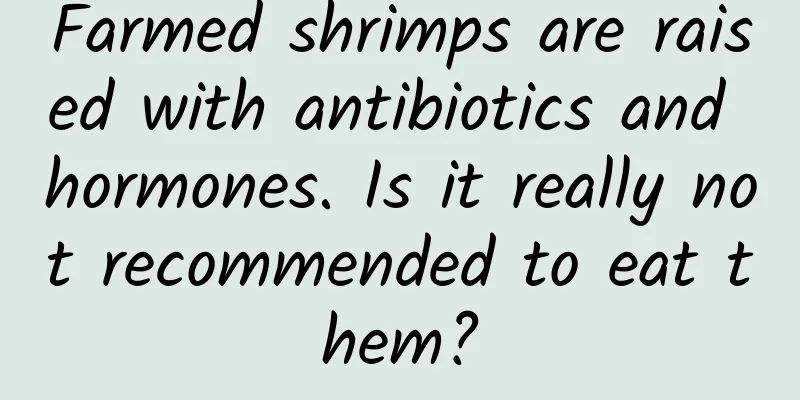Farmed shrimps are raised with antibiotics and hormones. Is it really not recommended to eat them?

|
“Farmed shrimp cannot metabolize harmful substances, so they cannot be eaten .” People often say on the Internet that you should never eat farmed shrimp. In order to prevent disease, farmed shrimp often use a lot of antibiotics, hormones, etc. However, shrimp do not have livers, so these drugs cannot be excreted at all. They can only remain in the body and be absorbed by itself, that is, in the shrimp meat. Rumor Analysis In fact, the content of veterinary drugs in shrimps that are farmed in a regular manner is usually very low, and it can be guaranteed to be safe. Therefore, you don’t have to worry about harming the human body when eating shrimps and other aquatic products normally. Shrimp is not only delicious but also nutritious, and is loved by everyone. White shrimp, river shrimp, mud shrimp, mantis shrimp, crayfish, all taste good no matter how they are cooked. However, people often say on the Internet that those so-called sea-caught shrimps are actually farmed. How can there be so many wild-caught shrimps? Not only Macrobrachium rosenbergii, but also mud shrimp, white shrimp, etc., are all farmed at a high density. In order to prevent shrimp from getting sick, a large amount of antibiotics are often used. In order to make shrimp grow fast and big, taurine and sulfonic acid hormones are also added. Because shrimp do not have livers, these antibiotics cannot be excreted at all and can only remain in the body and be absorbed by itself, that is, remain in the shrimp meat . Are all shrimps really farmed? Are they all fed drugs? Can we still eat shrimps without worry? Are all the shrimp we eat farmed? We cannot say that all the shrimps we eat currently are farmed, but it is true that most of them are farmed, accounting for more than 80% . According to data from the Ministry of Agriculture and Rural Affairs, in 2023, my country's total annual aquatic product output will reach 71 million tons, an increase of 3.4% over the previous year. Among them, the aquaculture output is expected to be 58.12 million tons, accounting for 82% of the total aquatic product output. There are more than 300 aquaculture species, including fish, shrimp, crab, shellfish, algae and other aquatic species. From a per capita perspective, the per capita possession of aquatic products exceeds 48 kilograms. Specifically for shrimp, according to the China Fisheries Statistical Yearbook, China's shrimp production showed an overall upward trend from 2013 to 2020, reaching 6.3073 million tons in 2020, up 3.94% year-on-year. Among them, freshwater farmed shrimp accounted for 55.21% of the total production, marine farmed shrimp accounted for 23.58%, and farmed shrimp accounted for 78.79% overall. Freshwater fished shrimp accounted for only 2.08%, and marine fished shrimp accounted for 19.13. From the perspective of the main species, the main species of marine shrimp farming in my country are currently whiteleg shrimp, giant tiger shrimp, Chinese shrimp and Japanese shrimp. Therefore, most of the shrimp we eat are indeed farmed. Why are shrimps farmed? So why are they all farmed? Mainly because wild caught ones are not edible enough and not tasty enough. With the improvement of living standards, we eat more and more aquatic products such as fish and shrimp. Moreover, fish and shrimp are also what is often called white meat in nutrition - low in fat and high in protein. They are healthy meats and are therefore even more popular. Data shows that from 2013 to 2022, the total domestic supply of aquatic products in my country has continued to increase, and the edible consumption has shown a clear growth trend. The total fresh weight of animal aquatic products consumed has increased from 32.7 million tons to 48.37 million tons, with an average annual growth rate of 4.45%. In 2022, the per capita fresh weight of animal aquatic products consumed by Chinese residents was 34.27 kg, an increase of 43% from 23.92 kg in 2013. Although we eat more seafood, it is still not enough to meet the recommended healthy intake. The Chinese Residents' Balanced Diet Pagoda (2022) recommends that the daily recommended intake of aquatic products and livestock and poultry meat is 40~75g (referring to the edible part of the food). Based on the average edible ratio of aquatic products of 54.50%, the daily consumption of fresh aquatic products per person needs to reach 73.39~137.61g, that is, the annual consumption reaches 26.79~50.23kg in fresh weight, with a median of 38.51kg. Compared with the median, there is still a difference of 11.04%, that is, 4.25kg in fresh weight. Currently, 80% of them are farmed, and we cannot eat the recommended amount for health. If we eat according to the healthy intake recommended by the dietary guidelines, it is definitely not enough if we rely entirely on wild fish and shrimp caught from nature. After all, the production cycle of wild fish and shrimp is long and the yield is low. Therefore, large quantities of farmed fish and shrimp are needed. Copyright images in the gallery. Reprinting and using them may lead to copyright disputes. Moreover, with the increasing progress of environmental protection concepts, many places in our country are restricting fishing, such as the Yangtze River Basin, which has started a ten-year fishing ban. In the future, the amount of breeding will be even greater. Is it true that farmed shrimp cannot be eaten? When it comes to farming, everyone will think of them being fed drugs. We often see on the Internet that shrimp and other aquatic products contain excessive amounts of veterinary drugs and antibiotics. Why are they excessive? Are they really fed drugs? 1 Are farmed shrimp really fed with drugs? Animals like shrimps can also get sick. Wild shrimps are mostly dead if no one takes care of them. But farmers still want to sell farmed shrimps, so of course they have to be treated when they get sick. Therefore, some drugs are indeed used in the shrimp farming process. If someone violates the rules in these links, the shrimps will have excessive drug content. In addition, banned drugs are often added to aquatic products during processing, packaging, storage, transportation, and sales. Aquatic products are prone to abrasions during transportation and storage. If the water environment is not clean, saprolegniasis is likely to occur, affecting the survival rate. Therefore, some vendors will also use some drugs in the storage pools for transporting animals to prevent and treat diseases. In addition, pollution in the breeding environment may also lead to the detection of veterinary drug and pesticide residues. For example, some farmers used drugs to disinfect the breeding environment, but when they continued breeding, they did not fully clean and purify the pond before breeding other animals, which may lead to the accumulation of veterinary drugs. 2 Is the environment for shrimp farming unsafe? But when many people talk about aquaculture, they think it is bad, thinking that many animals are crowded in one place, high density breeding, bad environment, easy to get sick, etc. In fact, this may be everyone's stereotype. In fact, with the development of technology, aquaculture has undergone great changes. Now China's aquaculture has undergone great changes. Now, a deep-sea fishery can raise 100,000 tons! For example, in 2021, Asia's largest deep-sea intelligent cage "Jinghai 001" was put into use. It is a cage for breeding in the deep sea area, and the environment is much better. Image source: CCTV News Client In 2022, the world's first 100,000-ton smart fishery large-scale aquaculture vessel "Guoxin No. 1" was delivered and put into operation. The "shipboard cabin farming" model he pioneered has pushed the aquaculture area from the nearshore to the deep sea. It has 15 aquaculture cabins and nearly 90,000 cubic meters of aquaculture water. The designed annual production of high-quality fish is 3,700 tons. 3 Farmed shrimp are edible! What people are most worried about is whether it is safe. Many people even say that farmed shrimp cannot metabolize harmful substances. In fact, the content of veterinary drugs in regular farmed shrimp is usually very low, so it can be guaranteed to be safe. According to the data from my country's fifth total diet study, the overall risk of veterinary drug residues in the aquatic products we consume daily is very low. In the first half of 2023, the national production area aquatic product veterinary drug residue monitoring pass rate was 99.2%, and the production area aquatic product veterinary drug residue monitoring pass rate remained stable at more than 99%. The large yellow croaker, turbot, flounder, rainbow trout, sea bass, channel catfish, catfish, shrimp and crayfish sampled all passed. Therefore, you don’t need to worry about harm to the human body when eating shrimp and other aquatic products normally. How to Eat Shrimp Healthy? 1 Eat regular farmed and sold single shrimp In fact, food safety is not zero risk. It is impossible to avoid the presence of various known and unknown hazardous substances in the environment. At present, the world is using food safety regulatory systems to control possible risks to an acceptable safety level to ensure people's safety. Shrimp that is formally farmed and sold usually has stricter control over food safety. Therefore, it is recommended that you go to regular restaurants to eat shrimps, and try to buy shrimps from regular supermarkets, markets or e-commerce platforms. 2 Eat in moderation Shrimp is delicious and nutritious, and many people like to eat it, but I still recommend that you eat it in moderation. Copyright images in the gallery. Reprinting and using them may lead to copyright disputes. The basic principle of a healthy diet recommended by the dietary guidelines is to eat a variety of foods, eat all kinds of foods, but not too much of any one food. Ensuring food diversity and eating all kinds of foods can, on the one hand, prevent us from eating only one kind of food and causing excessive intake of possible harmful substances, thus reducing the risk; on the other hand, it can also help us take in more balanced nutrition and promote physical health. The Chinese Residents' Dietary Pagoda recommends that we eat 120-200 grams of animal food every day and eat aquatic products twice a week. Among them, the recommended daily intake of livestock and poultry meat is 40-75 grams. Common aquatic products include fish, shrimp, crab and shellfish, and the recommended daily intake is 40-75 grams. As long as you don't eat a lot every day, you don't have to worry about veterinary drug residues and other problems. Looking in the mirror of rumors Currently, the world is using food safety supervision systems to control possible risks to an acceptable safety level to ensure people's safety. Therefore, when we see some absolute information about food on the Internet, we should learn to make objective judgments and try to avoid looking at it with stereotypes. References [1] The Ministry of Agriculture and Rural Affairs held a press conference on the "China Fisheries Administration Sword" law enforcement action. [Ministry of Agriculture and Rural Affairs Fisheries Administration Center] The Ministry of Agriculture and Rural Affairs held a press conference on the "China Fisheries Administration Sword" law enforcement action. (agri.cn) [2] Statistical analysis of China’s shrimp production, freshwater aquaculture and fishing production_China Economics_China_Enterprise (sohu.com) [3] China’s Residents’ Aquatic Product Consumption Estimation and Analysis Report (2023) Fifth Total Diet Report. [4] Notice of the Ministry of Agriculture and Rural Affairs on the Scope and Time of Fishing Ban in Key Waters of the Yangtze River Basin [5] The pass rate of veterinary drug residue monitoring in aquatic products nationwide in the first half of 2023 was 99.2% (moa.gov.cn) [6] Mu Yingchun, Xu Jinhua, Ren Yuanyuan, et al. General analysis of quality and safety risk of key aquaculture products[J]. China Fisheries Quality and Standards, 2021, 11(06): 52-60. [7] Minasha. Research on the current status and problems of my country's aquatic product quality and safety risk analysis system[D]. Ocean University of China, 2015. Planning and production Author: Ruan Guangfeng, Deputy Director of Kexin Food and Health Information Exchange Center Review丨Zhang Yu, researcher/PhD, Chinese Center for Disease Control and Prevention, national health science expert Planning丨Yinuo Editor: Yinuo Proofread by Xu Lailinlin The cover image and the images in this article are from the copyright library Reprinting may lead to copyright disputes |
>>: How to use AED and seize the golden 4 minutes of "sudden death rescue"?
Recommend
Swift AsyncThrowingStream and AsyncStream code examples
Preface AsyncThrowingStream and AsyncStream are p...
2007-2015: Two tables to show the competition history between iPhone and Android
Mary Meeker has released the 2016 Internet Trends...
BYD released Song L, positioning it as a hunting SUV, with a pre-sale price starting at 220,000 yuan, and was criticized for its low cost performance
On October 31, BYD officially announced that the ...
Should you upgrade your iPhone to iOS 10?
[51CTO.com Quick Translation] iOS 10 looks good, ...
National down jacket warning! Wear thicker clothes
From November 19 to 22, a new wave of cold air wi...
Why are there so many termites recently?
Mixed Knowledge Specially designed to cure confus...
You can't fart in the space station? Are these rumors about astronauts true?
Living in a "mansion" worth tens of bil...
Android source code advanced in-depth understanding of the working principle of Retrofit
[[422495]] This article is reprinted from the WeC...
Is it ok to eat a whole duck that costs 10 yuan on the roadside?
This article was reviewed by Pa Li Ze, chief phys...
How to position a short video account?
Nowadays, many people regard shooting short video...
Himalaya product operation analysis
In my childhood memory, there was always a radio ...
In winter, I want to sleep until I wake up naturally, and wake me up from my dream with a pee
Getting up to go to the bathroom at night in wint...
Mars 2020 "Perseverance" rover, the technology for detecting life is very good!
[Mobile software: Bo Ke Yuan] Scientists have use...
Something big happened today!
Two years ago, on July 23, 2020, the Long March 5...
Former LinkedIn boss Zhang Ximeng: The era of using large amounts of money to buy traffic is gone!
Zhang Ximeng Silicon Valley big data analysis and...









